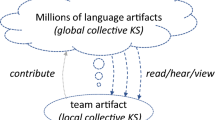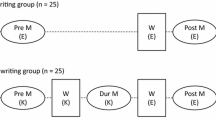Abstract
This descriptive exploratory study considers whether a simple sorting task can elicit readers’ knowledge structure in learners’ first and second language. In this investigation, knowledge structure is considered from a symbolic connectionist viewpoint as the fundamental pre-meaningful aspect of knowledge, where structure is the precursor of knowledge acquisition and the underpinning of meaningful activity. Chinese–English (C–E) bilingual participants (n = 23) were assigned to one of four counter-balanced conditions to complete two presorting tasks, read an English expository text passage, and then complete two post-sorting tasks including: CE-read-EC, CE-read-EC, EC-read-EC, and EC-read-CE. Data analysis focused on the knowledge structure measures elicited by the four sorting tasks. Results show that both the reading and the sorting elicitation task itself differentially influenced knowledge structure; the Chinese post-sorting task immediately after reading the English text led to a relatively more relational structure than did the English post-sorting task. Individual’s knowledge structure elicited by the sorting tasks was not much like those of other students, but each individual’s self-to-self structure in Chinese and English were somewhat alike before reading (r = .35, 13 % overlap) and moderately alike after reading (r = .62, 39 % overlap). These findings add to the evidence base that sorting tasks can elicit knowledge structures in dual language settings.




Similar content being viewed by others
References
Anderson, R. C. (1984). Some reflections on the acquisition of knowledge. Educational Researcher, 13(10), 5–10.
Aronoff, J. M., Gonnermanb, L. M., Almorc, A., Arunachalam, S., Kempler, D., & Andersen, E. S. (2005). Information content versus relational knowledge: Semantic deficits in patients with Alzheimer’s disease. Neuropsychologia, 44, 21–35.
Bonilla, J. L., & Johnson, M. K. (1995). Semantic space in Alzheimer’s disease patients. Neuropsychology, 9(3), 345–353.
Britton, B. K., & Gülgöz, S. (1991). Using Kintsch’s computational model to improve instructional text: Effects of repairing inference calls on recall and cognitive structures. Journal of Educational Psychology, 83(3), 329–345.
Champagne, A. B., Klopfer, L. E., Desena, A. T., & Squires, D. A. (1981). Structural representations of student’s knowledge before and after science instruction. Journal of Research in Science Teaching, 18(2), 97–111.
Clariana, R. B. (2010). Multi-decision approaches for eliciting knowledge structure. In D. Ifenthaler, P. Pirnay-Dummer, & N. M. Seel (Eds.), Computer-based diagnostics and systematic analysis of knowledge (pp. 41–59). Berlin: Springer.
Clariana, R. B., Rysavy, M. D., & Taricani, E. M. (2015). Text signals influence team artifacts. Educational Technology Research and Development, 63, 35–52.
Clariana, R. B., & Wallace, P. (2007). A computer-based approach for deriving and measuring individual and team knowledge structure from essay questions. Journal of Educational Computing Research, 37(3), 211–227.
Clariana, R. B., & Wallace, P. E. (2009). A comparison of pair-wise, list-wise, and clustering approaches for eliciting structural knowledge. International Journal of Instructional Media, 36(3), 287–302.
Clark, D. B., D’Angelo, C. M., & Schleigh, S. P. (2011). Comparison of student’s knowledge Structure coherence and understanding of force in the Philippines, Turkey, China, Mexico, and the United States. Journal of the Learning Sciences, 20, 207–261. doi:10.1080/10508406.2010.508028.
Collins, A. M., & Quillian, M. R. (1969). Retrieval lime from long-term memory. Journal of Verbal Learning and Verbal Behavior, 8, 240–247.
Davis, M. H., & Guthrie, J. T. (2015). Measuring reading comprehension of content area texts using an assessment of knowledge organization. The Journal of Educational Research, 108(2), 148–164. doi:10.1080/00220671.2013.863749.
Fitzpatrick, T., & Izura, C. (2011). Word associations in L1 and L2: An exploratory study of response types, response times, and interlingual mediation. Studies in Second Language Acquisition, 33, 373–398.
Fuessel, D., & Isermann, R. (2000). Hierarchical motor diagnosis utilizing structural knowledge and a self-learning neuro-fuzzy scheme. IEEE Transactions on Industrial Electronics, 47(5), 1070–1077.
Galton, F. R. S. (1879). Psychometric experiments. Brain, 2, 149–162.
Gonzalvo, P., Canas, J. J., & Bajo, M. (1994). Structural representations in knowledge acquisition. Journal of Educational Psychology, 86(4), 601–616.
Günther, J., Bergner, A., Hendlich, M., & Klebe, G. (2003). Utilizing structural knowledge in drug design strategies: Applications using Relibase. Journal of Molecular Biology, 326(2), 621–636.
Guthrie, J. T., Wigfield, A., Barbosa, P., Perencevich, K. C., Taboada, A., Davis, M. H., et al. (2004). Increasing reading comprehension and engagement through concept-oriented reading Instruction. Journal of Educational Psychology, 96, 403–423. doi:10.1037/0022-0663.96.3.403.
Hakan, K. U. R. T., Ekici, G., Aktas, M., & Aksu, O. (2013). Determining biology student teachers’ cognitive structure on the concept of “diffusion” through the free word-association test and the drawing-writing technique. International Education Studies, 6(9), p187.
Hwang, G. J., Wu, P. H., & Ke, H. R. (2011). An interactive concept map approach to supporting mobile learning activities for natural science courses. Computers and Education, 57(4), 2272–2280.
Jonassen, D. H., Beissner, K., & Yacci, M. (1993). Structural knowledge: Techniques for representing, conveying, and acquiring structural knowledge. Hillsdale: Lawrence Erlbaum Associates.
Kaufman, A. B., Green, S. R., Seitz, A. R., & Burgess, C. (2012). Using a self-organizing map (SOM) and the hyperspace analog to language (HAL) model to identify patterns of syntax and structure in the songs of humpback whales. International Journal of Comparative Psychology, 25, 237–275.
Kim, K., & Clariana, R. B. (2015). Knowledge structure measures of reader’s situation models across languages: Translation engenders richer structure. Technology Knowledge and Learning, 20, 249–268.
Kroll, J. F., & de Groot, A. M. B. (2014). Lexical and conceptual memory in the bilingual: Mapping form to meaning in two languages. In J. F. Kroll & A. M. B. de Groot (Eds.), Tutorials in bilingualism (pp. 169–200). New York: Psychology Press.
Martinez, M. M. (2010). Learning and cognition: The design of the mind. Upper Saddle River, NJ: Merrill.
National Research Council. (2001). Knowing what students know: The science and design of educational assessment. Washington: National Academies Press.
Novak, J. D. (1990). Concept mapping: A useful tool for science education. Journal of Research in Science Teaching, 27(10), 937–949.
Ober, B. A., & Shenaut, G. K. (1999). Well-organized conceptual domains in Alzheimer’s disease. Journal of the International Neuropsychological Society, 5(7), 676–684.
Ozgungor, S., & Guthrie, J. T. (2004). Interactions among elaborative interrogation, knowledge, and interest in the process of constructing knowledge from text. Journal of Educational Psychology, 96, 437–443. doi:10.1037/0022-0663.96.3.437.
Rumlehart, D. E., Smolensky, P., McClelland, J. L., & Hinton, G. E. (1986). Schemata and sequential thought processes in PDP models. In D. E. Rumelhart & J. L. McClelland (Eds.), Parallel distributed processing: Explorations in the microstructure of cognition (Vol. 2, pp. 7–57)., Psychological and biological models Cambridge: MIT Press.
Schvaneveldt, R. (1990). Pathfinder associative networks: Studies in knowledge organization (p. 1990). Norwood: Ablex.
Schvaneveldt, R. (2016). Curated bibliography of 272 published investigation using Pathfinder network methods. http://interlinkinc.net/References.html.
Shavelson, R. J., & Stanton, G. C. (1975). Construct validation: Methodology and application to three measures of cognitive structure. Journal of Educational Measurement, 12(2), 67–85.
Spinozzi, G. (1993). Development of spontaneous classificatory behavior in chimpanzees (Pan troglodytes). Journal of Comparative Psychology, 107, 193–200. doi:10.1037/0735-7036.107.2.193.
Suen, H. K., & Murphy, L. C. R. (1999). Validating measures of structural knowledge through the multitrait-multimethod matrix. Presented at AERA.
Taricani, E. M., & Clariana, R. B. (2006). A technique for automatically scoring open-ended concept maps. Educational Technology Research and Development, 54(1), 65–82.
Trumpower, D. L., & Goldsmith, T. E. (2004). Structural enhancement of learning. Contemporary Educational Psychology, 29, 426–446.
Willson, V. L., & Rupley, W. H. (1997). A structural equation model for reading comprehension based on background, phonemic, and strategy knowledge. Scientific Studies of Reading, 1(1), 45–63.
Zareva, A., & Wolter, B. (2012). The ‘promise’ of three methods of word association analysis to L2 lexical research. Second Language Research, 28, 41–67.
Zhao, X., & Li, P. (2013). Simulating cross-language priming with a dynamic computational model of the lexicon. Bilingualism Language and Cognition, 16, 288–303. doi:10.1017/S1366728912000624.
Acknowledgments
This is a research project for Dr. Roy Clariana’s course, LDT 594 Research Topics. Special thanks go to Yaozu Dong, Yuanyuan Shang, Yu Yan, and Shulong Yan for the support.
Author information
Authors and Affiliations
Corresponding author
Rights and permissions
About this article
Cite this article
Tang, H., Clariana, R. Leveraging a Sorting Task as a Measure of Knowledge Structure in Bilingual Settings. Tech Know Learn 22, 23–35 (2017). https://doi.org/10.1007/s10758-016-9290-z
Published:
Issue Date:
DOI: https://doi.org/10.1007/s10758-016-9290-z




